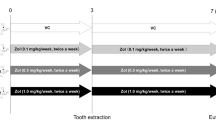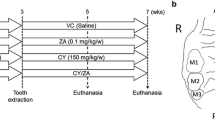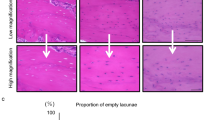Abstract
Nitrogen-containing bisphosphonates such as zoledronic acid (ZOL) and pamidronate have been widely and successfully used for the treatment of cancer patients with bone metastases and/or hypercalcemia. Accumulating recent reports have shown that cancer patients who have received these bisphosphonates occasionally manifest bisphosphonate-related osteonecrosis of the jaw (BRONJ) following dental treatments, including tooth extraction. However, little is known about the pathogenesis of BRONJ to date. Here, to understand the underlying pathogenesis of BRONJ, we examined the effects of ZOL on wound healing of the tooth extraction socket using a mouse tooth extraction model. Histomorphometrical analysis revealed that the amount of new bone and the numbers of blood vessels in the socket were significantly decreased in ZOL-treated mice compared to control mice. Consistent with these results, ZOL significantly inhibited angiogenesis induced by vascular endothelial growth factor in vivo and the proliferation of endothelial cells in culture in a dose-dependent manner. In contrast, etidronate, a non-nitrogen-containing bisphosphonate, showed no effects on osteogenesis and angiogenesis in the socket. ZOL also suppressed the migration of oral epithelial cells, which is a crucial step for tooth socket closure. In addition, ZOL promoted the adherence of Streptococcus mutans to hydroxyapatite and the proliferation of oral bacteria obtained from healthy individuals, suggesting that ZOL may increase the bacterial infection. In conclusion, our data suggest that ZOL delays wound healing of the tooth extraction socket by inhibiting osteogenesis and angiogenesis. Our data also suggest that ZOL alters oral bacterial behaviors. These actions of ZOL may be relevant to the pathogenesis of BRONJ.









Similar content being viewed by others
References
Rogers MJ, Watts DJ, Russell RG (1997) Overview of bisphosphonates. Cancer (Phila) 80:1652–1660
Licata AA (2005) Discovery, clinical development, and therapeutic uses of bisphosphonates. Ann Pharmacother 39:668–677
Michaelson MD, Smith MR (2005) Bisphosphonates for treatment and prevention of bone metastases. J Clin Oncol 23:8219–8224
Delmas PD (2005) The use of bisphosphonates in the treatment of osteoporosis. Curr Opin Rheumatol 17:462–466
DiCaprio MR, Enneking WF (2005) Fibrous dysplasia. Pathophysiology, evaluation, and treatment. J Bone Joint Surg [Am] 87:1848–1864
Reid IR, Miller P, Lyles K, Fraser W, Brown JP, Saidi Y, Mesenbrink P, Su G, Pak J, Zelenakas K, Luchi M, Richardson P, Hosking D (2005) Comparison of a single infusion of zoledronic acid with risedronate for Paget’s disease. N Engl J Med 353:898–908
Hortobagyi GN, Theriault RL, Porter L, Blayney D, Lipton A, Sinoff C, Wheeler H, Simeone JF, Seaman J, Knight RD (1996) Efficacy of pamidronate in reducing skeletal complications in patients with breast cancer and lytic bone metastases. Protocol 19. Aredia Breast Cancer Study Group. N Engl J Med 335:1785–1791
Ashcroft AJ, Davies FE, Morgan GJ (2003) Aetiology of bone disease and the role of bisphosphonates in multiple myeloma. Lancet Oncol 4:284–292
Berenson JR, Hillner BE, Kyle RA, Anderson K, Lipton A, Yee GC, Biermann JS (2002) American Society of Clinical Oncology clinical practice guidelines: the role of bisphosphonates in multiple myeloma. J Clin Oncol 20:3719–3736
Coleman RE (2002) Future directions in the treatment and prevention of bone metastases. Am J Clin Oncol 25:S32–S38
Djulbegovic B, Wheatley K, Ross J, Clark O, Bos G, Goldschmidt H, Cremer F, Alsina M, Glasmacher A (2001) Bisphosphonates in multiple myeloma. Cochrane Database Syst Rev 4:CD003188
Ferretti G, Fabi A, Carlini P, Papaldo P, Cordiali Fei P, Di Cosimo S, Salesi N, Giannarelli D, Alimonti A, Di Cocco B, D’Agosto G, Bordignon V, Trento E, Cognetti F (2005) Zoledronic-acid-induced circulating level modifications of angiogenic factors, metalloproteinases and proinflammatory cytokines in metastatic breast cancer patients. Oncology 69:35–43
Hillner BE, Ingle JN, Chlebowski RT, Gralow J, Yee GC, Janjan NA, Cauley JA, Blumenstein BA, Albain KS, Lipton A, Brown S (2003) American Society of Clinical Oncology 2003 update on the role of bisphosphonates and bone health issues in women with breast cancer. J Clin Oncol 21:4042–4057
Hillner BE, Weeks JC, Desch CE, Smith TJ (2000) Pamidronate in prevention of bone complications in metastatic breast cancer: a cost-effectiveness analysis. J Clin Oncol 18:72–79
Osanai T, Tsuchiya T, Ogino T, Nakahara K (2006) Long-term prevention of skeletal complications by pamidronate in a patient with bone metastasis from endometrial carcinoma: a case report. Gynecol Oncol 100:195–197
Smith MR (2005) Zoledronic acid to prevent skeletal complications in cancer: corroborating the evidence. Cancer Treat Rev 31(Suppl 3):19–25
Rogers MJ, Gordon S, Benford HL, Coxon FP, Luckman SP, Monkkonen J, Frith JC (2000) Cellular and molecular mechanisms of action of bisphosphonates. Cancer (Phila) 88:2961–2978
Luckman SP, Hughes DE, Coxon FP, Graham R, Russell G, Rogers MJ (1998) Nitrogen-containing bisphosphonates inhibit the mevalonate pathway and prevent post-translational prenylation of GTP-binding proteins, including Ras. J Bone Miner Res 13:581–589
Russell RG, Rogers MJ (1999) Bisphosphonates: from the laboratory to the clinic and back again. Bone (NY) 25:97–106
Marx RE (2003) Pamidronate (Aredia) and zoledronate (Zometa) induced avascular necrosis of the jaws: a growing epidemic. J Oral Maxillofac Surg 61:1115–1117
Ruggiero SL, Mehrotra B, Rosenberg TJ, Engroff SL (2004) Osteonecrosis of the jaws associated with the use of bisphosphonates: a review of 63 cases. J Oral Maxillofac Surg 62:527–534
Pires FR, Miranda A, Cardoso ES, Cardoso AS, Fregnani ER, Pereira CM, Correa ME, Almeida JP, Alves Fde A, Lopes MA, de Almeida OP (2005) Oral avascular bone necrosis associated with chemotherapy and biphosphonate therapy. Oral Dis 11:365–369
Assael LA (2004) New foundations in understanding osteonecrosis of the jaws. J Oral Maxillofac Surg 62:125–126
Hellstein JW, Marek CL (2004) Bis-phossy jaw, phossy jaw, and the 21st century: bisphosphonate-associated complications of the jaws. J Oral Maxillofac Surg 62:1563–1565
Jimenez-Soriano Y, Bagan JV (2005) Bisphosphonates, as a new cause of drug-induced jaw osteonecrosis: an update. Med Oral Patol Oral Cir Bucal 10(Suppl 2):E88–E91
Melo MD, Obeid G (2005) Osteonecrosis of the jaws in patients with a history of receiving bisphosphonate therapy: strategies for prevention and early recognition. J Am Dent Assoc 136:1675–1681
Olson KB, Hellie CM, Pienta KJ (2005) Osteonecrosis of jaw in patient with hormone-refractory prostate cancer treated with zoledronic acid. Urology 66:658
Vannucchi AM, Ficarra G, Antonioli E, Bosi A (2005) Osteonecrosis of the jaw associated with zoledronate therapy in a patient with multiple myeloma. Br J Haematol 128:738
Ruggiero SL, Dodson TB, Assael LA, Landesberg R, Marx RE, Mehrotra B (2009) American Association of Oral and Maxillofacial Surgeons position paper on bisphosphonate-related osteonecrosis of the jaws: 2009 update. J Oral Maxillofac Surg 67:2–12
Fournier P, Boissier S, Filleur S, Guglielmi J, Cabon F, Colombel M, Clezardin P (2002) Bisphosphonates inhibit angiogenesis in vitro and testosterone-stimulated vascular regrowth in the ventral prostate in castrated rats. Cancer Res 62:6538–6544
Wood J, Bonjean K, Ruetz S, Bellahcene A, Devy L, Foidart JM, Castronovo V, Green JR (2002) Novel antiangiogenic effects of the bisphosphonate compound zoledronic acid. J Pharmacol Exp Ther 302:1055–1061
Hellstein JW, Marek CL (2005) Bisphosphonate osteochemonecrosis (bis-phossy jaw): is this phossy jaw of the 21st century? J Oral Maxillofac Surg 63:682–689
Sedghizadeh PP, Kumar SK, Gorur A, Schaudinn C, Shuler CF, Costerton JW (2008) Identification of microbial biofilms in osteonecrosis of the jaws secondary to bisphosphonate therapy. J Oral Maxillofac Surg 66:767–775
Oikawa T, Sasaki M, Inose M, Shimamura M, Kuboki H, Hirano S, Kumagai H, Ishizuka M, Takeuchi T (1997) Effects of cytogenin, a novel microbial product, on embryonic and tumor cell-induced angiogenic responses in vivo. Anticancer Res 17:1881–1886
Hata K, Nishimura R, Muramatsu S, Matsuda A, Matsubara T, Amano K, Ikeda F, Harley VR, Yoneda T (2008) Paraspeckle protein p54nrb links Sox9-mediated transcription with RNA processing during chondrogenesis in mice. J Clin Invest 118:3098–3108
Yang J, Nandi S (1983) Growth of cultured cells using collagen as substrate. Int Rev Cytol 81:249–286
Kubota Y, Kleinman HK, Martin GR, Lawley TJ (1988) Role of laminin and basement membrane in the morphological differentiation of human endothelial cells into capillary-like structures. J Cell Biol 107:1589–1598
Matsumoto M, Tsuji M, Sasaki H, Fujita K, Nomura R, Nakano K, Shintani S, Ooshima T (2005) Cariogenicity of the probiotic bacterium Lactobacillus salivarius in rats. Caries Res 39:479–483
Muller S, Migianu E, Lecouvey M, Kraemer M, Oudar O (2005) Alendronate inhibits proliferation and invasion of human epidermoid carcinoma cells in vitro. Anticancer Res 25:2655–2660
Ribatti D, Nico B, Mangieri D, Maruotti N, Longo V, Vacca A, Cantatore FP (2007) Neridronate inhibits angiogenesis in vitro and in vivo. Clin Rheumatol 26:1094–1098
Yamagishi S, Abe R, Inagaki Y, Nakamura K, Sugawara H, Inokuma D, Nakamura H, Shimizu T, Takeuchi M, Yoshimura A, Bucala R, Shimizu H, Imaizumi T (2004) Minodronate, a newly developed nitrogen-containing bisphosphonate, suppresses melanoma growth and improves survival in nude mice by blocking vascular endothelial growth factor signaling. Am J Pathol 165:1865–1874
Reid IR (2009) Osteonecrosis of the jaw: who gets it, and why? Bone (NY) 44:4–10
Allen MR, Burr DB (2008) Mandible matrix necrosis in beagle dogs after 3 years of daily oral bisphosphonate treatment. J Oral Maxillofac Surg 66:987–994
Sonis ST, Watkins BA, Lyng GD, Lerman MA, Anderson KC (2009) Bony changes in the jaws of rats treated with zoledronic acid and dexamethasone before dental extractions mimic bisphosphonate-related osteonecrosis in cancer patients. Oral Oncol 45:164–172
Dimopoulos MA, Kastritis E, Bamia C, Melakopoulos I, Gika D, Roussou M, Migkou M, Eleftherakis-Papaiakovou E, Christoulas D, Terpos E, Bamias A (2009) Reduction of osteonecrosis of the jaw (ONJ) after implementation of preventive measures in patients with multiple myeloma treated with zoledronic acid. Ann Oncol 20:117–120
Montefusco V, Gay F, Spina F, Miceli R, Maniezzo M, Teresa Ambrosini M, Farina L, Piva S, Palumbo A, Boccadoro M, Corradini P (2008) Antibiotic prophylaxis before dental procedures may reduce the incidence of osteonecrosis of the jaw in patients with multiple myeloma treated with bisphosphonates. Leuk Lymphoma 49:2156–2162
Ripamonti CI, Maniezzo M, Campa T, Fagnoni E, Brunelli C, Saibene G, Bareggi C, Ascani L, Cislaghi E (2009) Decreased occurrence of osteonecrosis of the jaw after implementation of dental preventive measures in solid tumour patients with bone metastases treated with bisphosphonates. The experience of the National Cancer Institute of Milan. Ann Oncol 20:137–145
Clezardin P (2005) Anti-tumour activity of zoledronic acid. Cancer Treat Rev 31(Suppl 3):1–8
Winter MC, Holen I, Coleman RE (2008) Exploring the antitumour activity of bisphosphonates in early breast cancer. Cancer Treat Rev 34:453–475
Montalvetti A, Bailey BN, Martin MB, Severin GW, Oldfield E, Docampo R (2001) Bisphosphonates are potent inhibitors of Trypanosoma cruzi farnesyl pyrophosphate synthase. J Biol Chem 276:33930–33937
Martin MB, Grimley JS, Lewis JC, Heath HT III, Bailey BN, Kendrick H, Yardley V, Caldera A, Lira R, Urbina JA, Moreno SN, Docampo R, Croft SL, Oldfield E (2001) Bisphosphonates inhibit the growth of Trypanosoma brucei, Trypanosoma cruzi, Leishmania donovani, Toxoplasma gondii, and Plasmodium falciparum: a potential route to chemotherapy. J Med Chem 44:909–916
Frith JC, Monkkonen J, Blackburn GM, Russell RG, Rogers MJ (1997) Clodronate and liposome-encapsulated clodronate are metabolized to a toxic ATP analog, adenosine 5′-(beta, gamma-dichloromethylene) triphosphate, by mammalian cells in vitro. J Bone Miner Res 12:1358–1367
Acknowledgments
We are grateful to Dr. Yoshinosuke Hamada and Dr. Nariaki Matsuura (Department of Functional Diagnostic Science, Osaka University Graduate School of Medicine) for technical support and helpful discussion. This work was supported in part by Ministry of Education, Science, Sports and Culture Grants-in-Aid for Scientific Research A (TY) and The 21st Century COE Program (TY).
Author information
Authors and Affiliations
Corresponding author
About this article
Cite this article
Kobayashi, Y., Hiraga, T., Ueda, A. et al. Zoledronic acid delays wound healing of the tooth extraction socket, inhibits oral epithelial cell migration, and promotes proliferation and adhesion to hydroxyapatite of oral bacteria, without causing osteonecrosis of the jaw, in mice. J Bone Miner Metab 28, 165–175 (2010). https://doi.org/10.1007/s00774-009-0128-9
Received:
Accepted:
Published:
Issue Date:
DOI: https://doi.org/10.1007/s00774-009-0128-9




